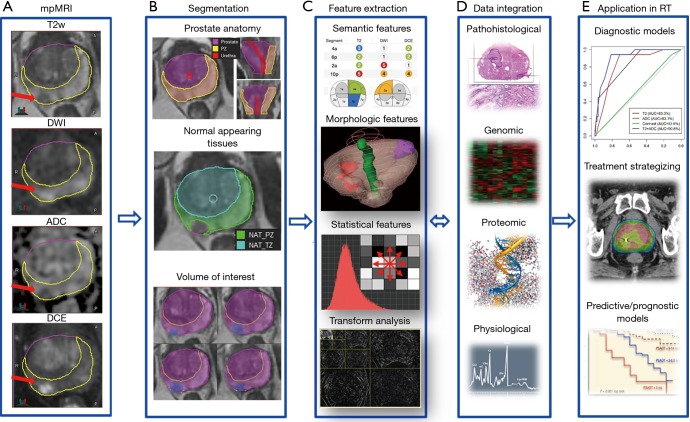Figure 1.
mpMRI radiomics in prostate RT. (A) mpMRI exam of the prostate typically includes acquisition of T2-weighted (T2w), diffusion-weighted imaging (DWI) and the associated apparent diffusion coefficient (ADC) map and dynamic contrast enhanced (DCE)-MRI. In this panel the T2w, DWI at high b-value (1,000 s/mm2), ADC and the early enhancing image in the DCE-MRI from radiotherapy patient is shown. The red arrows indicate a tumor in the peripheral zone (PZ). The tumor appears darker on T2w, brighter on the high b-value DWI and it is characterized with reduced diffusion (ADC) and increased perfusion (DCE-MRI); (B) segmentation of volumes of interest (VOI) in prostate cancer radiotherapy generally involves identification of prostate, urethra, PZ, transition zone (TZ), as shown in the top panel, and differentiation of normal appearing tissues (NAT) in PZ and TZ, as shown in the middle panel, along with delineation of the gross tumor volume (GTV) in 3D, as shown in the bottom panel; (C) radiomics features extracted from prostate mpMRI can be grouped into four major categories related, respectively, to semantic, morphological, statistical, and transform analysis. Semantic features refer to quantitative descriptors derived by the radiologists empirically when assessing mpMRI, morphological features are measures of geometrical shape and physical composition of the segmented VOIs, statistical features quantify the gray level intensity distribution and/or spatial relations between image voxels inside VOIs, and transform-based features depict repetitive or non-repetitive spatial patterns through mathematical transformation to the segmented image content; (D) to achieve holistic models, radiomics features should be integrated with other available biomarkers, such as data from clinical records, genomic profiling, proteomic screening, and physiological analysis; (E) application of integrated data/models could span the entire range of radiotherapy for prostate cancer, from aiding in diagnostic establishment to facilitating patient-individualized treatment strategizing to improving predictive and prognostic accuracy.

